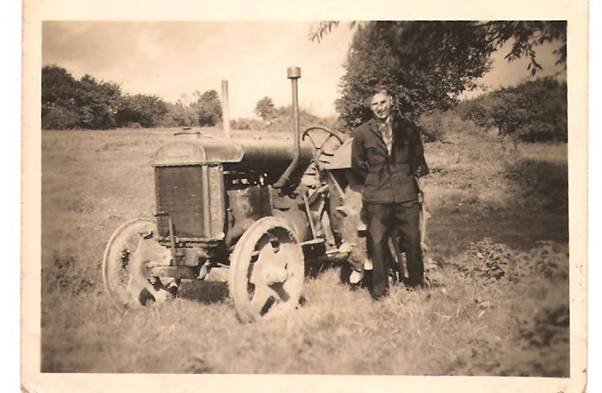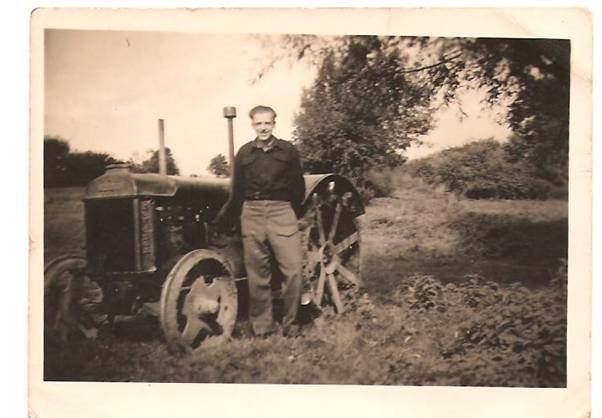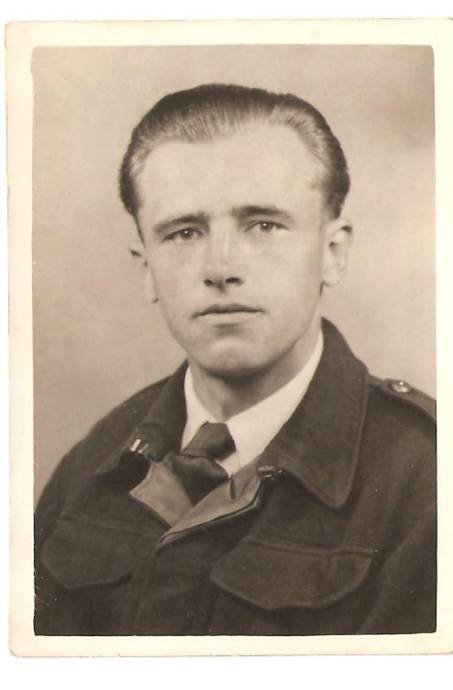Held at: | Private Collection |
Reference: | Herefordshire Family History Society |
Source: | Quarterly Journal ‘Herefordiensis’ |
Title: | Oral History: Memories of the Second World War in the Golden Valley |
Place name: | Golden Valley |
Date: | 1940s |
Description:
Introduction:
We are grateful to Eva Morgan for sending us this account of her recollections of wartime in the Golden Valley. As with the Prisoner of War camp in Dorstone described elsewhere on this website, the residents of the POW camp at Peterchurch seem to have settled easily into the local community and left lasting and fond memories very much at odds with those that might be expected of enemies in wartime. Eva’s observations of day-to-day life locally during the war and its aftermath are also fascinating.
Ewyas Lacy Study Group
PENLAN AS I KNEW IT-1942 ONWARDS
By Eva Morgan
First written October 19TH 2001 & modified thereafter
[Source: Herefordshire Family History Society -Quarterly Journal ‘Herefordiensis’]
My earliest memories of my home at Penlan, Peterchurch must be from just after the end of the Second World War. There were two Italian prisoners-of-war living in the house with us but I don’t remember their names. If the camp where they were billeted in, in this case on Wellbrook road in Peterchurch, was a distance from the farm where they were working regularly the farmer could ask for them to live at the farm with his family. I would imagine this was a popular move with the men as farmer’s wives [and certainly my mother] were usually good cooks and there was always plenty to eat even when food was still rationed. Rabbit figured pretty often on the menu [like alternate days! usually alternating with home-cured bacon, most of which was fat!] but was delicious and popular in the days before myximatosis. My mother used to tell in later life how she got so tired of trying to think of another way to cook rabbit & fat bacon, but I have wonderful memories of her roasted rabbit cooked on a bed of lovely bread, parsley & onion stuffing incorporated into delicious gravy. Rabbiting, with ferrets was a popular weekend pastime and essential work as five rabbits were said to eat as much as one sheep. Rabbits bred at an enormous pace like, well, like rabbits! About 1950 a rabbit catcher called Mr. Baker came to live at Westfield House, along the back road to Dorstone. He trapped & sold rabbits on the farms for miles including the 600 acres of what was always known as “The Dump”, the army ammunition store at Abbeydore now the training ground for the SAS. He let out rooms to a couple without a home from South Wales, the husband used to ride a motorcycle to Aberdare every day to teach. They had two little sons & the mother later became well known as Elaine Morgan, the playwright. Eventually they went to live up at The Birches on the Vaga Hill & I remember her so well helping serve the teas at Llanrosser Chapel anniversaries.
2017 I was changing services on my TV and heard a voice I recognised, yes it was Elaine Morgan’s lovely voice coming down the years, a recording was being used. I saved the recording on my Free view box.
The reason I remember the Italians so well was because of the baskets they made in the evenings out of split hazel, which they dyed red and green as well as leaving some natural. I wonder did they use natural dyes? If not where did they get the dye from as things were all very short for a long time after the war and they wouldn’t have had much if any money. The baskets were oblong in shape with a solid piece of wood forming the bottom with the upright spars stuck into it and woven in underneath. The sides sloped outwards slightly and there was a carrying handle. They were good and strong and Mum had hers for many years. I presume they sold some to locals but I don’t know. They also made Mum a basket with a lid attached to the main body of the basket by two circles of woven hazel on the one side and a peg and loop fastening on the other. She kept all her mending and sewing things in it and used it up until her death in 1982. My mother always said the Italians were lazy and expected her to wait on them so I have presumed they were from the south of Italy where I believe the women do the work and the men watch them!
The prisoners of war were based at the camp built for the purpose on the left-hand side of the Wellbrook road. The land belonged to the Smith family of High House, and eventually became part of the Crossways estate. There were several long huts covered with corrugated tin and lined with tongue and groove boarding. I can’t remember if they were all half moon shaped but I know most of them were. There was a superintendent who had separate quarters one of whom was a Cockney & married a local girl. They made a Chapel for their Roman Catholic worship in one of the huts and this was furnished with the chairs, organ and, maybe, other things, from the disused Church of England Chapel of Ease at Urishay Castle. Sadly these things were probably sold off or otherwise disposed of when the last prisoners left.
There was an awful shortage of housing after the war and most ex-service accommodation was utilised as housing for local people or refugees until new better housing could be built. In Peterchurch Closure Place was built and I knew two young local couples who moved from the camp to the new houses. One husband worked as a builder and his wife worked at Hartleys Jam Factory, at Webton Court, Kingstone. The other husband drove stock lorries for Clive Prosser, who built Tyneham Garage, which stood opposite what is now Golden Valley stores & was later used as the Wye valley Plastics/D.R.G. factory. It has now been demolished for houses to be built. His wife had come from Ireland to be barmaid at the Boughton Arms.
After the Italians left the Germans arrived. I was a bit older by then and remember with affection Emil and Otto [Carl]. I have photographs of them both, dressed in their Sunday best POW uniforms, with their pride and joy, my father’s green Standard Fordson tractor. With it they learned to plough and plant, to reap and mow. Otto earned my parents gratitude when he grabbed my small sister from virtually right in front of the carthorses my father was bringing into the stable. As they galloped round the corner into the farmyard, Otto, washing his hands at the outside tap, saw that Mary was playing right in their path. He vaulted the wall, about four and a half feet high, and scooped her up. Before they returned to Germany they were for a short time at a camp at Tupsley where Otto was converted to the Christian faith. He and my mother regularly wrote to each other and he sent photographs of the highlights of his life including his wedding to Gerda. When my parents moved to another farm in 1960 Mum lost his address. In about 1982, unfortunately after her death but while my father was still alive, a letter arrived at Penlan, by then the home of my husband & our two young sons, from Otto to say that his son would like to bring Otto and Gerda over to see where he had lived and worked and been so happy. They came and stayed with us for several days during the our pick-your-own strawberry season and ate Penlan strawberries with relish every day for at least two meals. Otto had changed little, still tall, dark and handsome and always smiling. He was pleased to see that the hedge he had pleached, learning as he went, at the bottom of the Castle Pitch was still growing well and kept trim. [It still is.] Otto hadn’t spoken English again since going home in 1947 but had kept in practice by reading his English Bible regularly. He & Gerda started going every November to Israel with their Church to work in recompense for what the Germans had done to the Jews. After the deaths of Gerda’s mother & aunt, for whom they cared until their deaths in their 90s, Otto & Gerda went to live on a kibbutz in Israel & he helped in the bakery there. He had trained as a baker before the war & returned to his trade afterwards. I have a photograph of him at the bakery door, as ever happy & smiling. He and I continued to correspond for many years. I wrote to him a couple of times a year & he rang me occasionally, he found it easier to speak than to write English. Latterly he & Gerda, who had dementia & eventually moved into a care home, moved back to Krempe to live with one of their sons. I have not heard from Otto for some years now so must presume he has died. He, like us, had never heard from Emil whose wife and son were in the East and we can only hope that he was reunited with them.
LATER USE OF THE CHURCH AT THE OLD CAMP.
For some years the local Catholics, including our wonderful German/Russian District Nurse, Ruth de Ropp, held their weekly services in the old Chapel shed led by a priest from Belmont Abbey, who used to cycle out here. The owner, who had had the property returned after the war, kept chickens in the other half of the same shed! Our then [for nearly 40 years] Rector, Revd John de la Tour Davies, was telephoned with an urgent message for one of the Catholic congregation so was directed to the shed. He was so astounded by the conditions in which they were worshiping that he sought the permission of the then Bishop of Hereford who sanctioned the use by the Catholics of our parish Church, St. Peters, a condition being that there was to be no publicity about the arrangement whatever. These services continued at 4pm every Sunday for a while & later, slightly less often, maybe fortnightly, for around 25 years until the Belmont Foundation found themselves unable to continue their outreach services. I think they had groups in the Welsh Newton area as well. By then of course more people had cars & were better able to travel to Belmont Abbey or St Francis Xavier in Hereford & the congregation had probably diminished as well.
-------------------------------------------
Addendum:
Shown below are photographs my mother took for Otto and Emil to send home to Germany. They were very proud, as was my Father, of the Fordson Standard tractor on spade lug wheels, which they learnt to drive and use. Otto pleached [cut down and laid] a hedge, learning as he went, which is still alive and well at Penlan. It is on the right hand side as you near the bottom of the Castle Pitch down to where the Oatley Brook runs under the bridge across the road. A little higher up on the same side of the road on the Castle Pitch, in the Urishay Castle Farm fields, there was a lime kiln when I was a child. It was bulldozed out into the field probably in the early 1950s.

Emil Franz, 1946

Otto Carl 1946

Otto Carl in POW uniform 1947
Observations:
None
Ref: rs_gdv_0166
